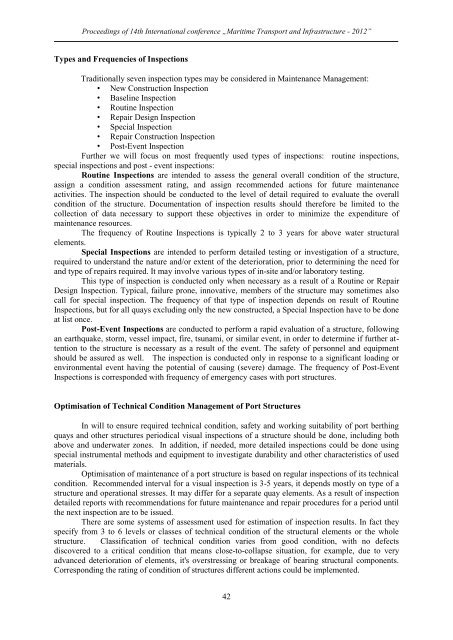14. starptautiskÄ konference 2012 - Latvijas JÅ«ras akadÄmija
14. starptautiskÄ konference 2012 - Latvijas JÅ«ras akadÄmija
14. starptautiskÄ konference 2012 - Latvijas JÅ«ras akadÄmija
You also want an ePaper? Increase the reach of your titles
YUMPU automatically turns print PDFs into web optimized ePapers that Google loves.
Proceedings of 14th International conference „Maritime Transport and Infrastructure - <strong>2012</strong>”Types and Frequencies of InspectionsTraditionally seven inspection types may be considered in Maintenance Management:• New Construction Inspection• Baseline Inspection• Routine Inspection• Repair Design Inspection• Special Inspection• Repair Construction Inspection• Post-Event InspectionFurther we will focus on most frequently used types of inspections: routine inspections,special inspections and post - event inspections:Routine Inspections are intended to assess the general overall condition of the structure,assign a condition assessment rating, and assign recommended actions for future maintenanceactivities. The inspection should be conducted to the level of detail required to evaluate the overallcondition of the structure. Documentation of inspection results should therefore be limited to thecollection of data necessary to support these objectives in order to minimize the expenditure ofmaintenance resources.The frequency of Routine Inspections is typically 2 to 3 years for above water structuralelements.Special Inspections are intended to perform detailed testing or investigation of a structure,required to understand the nature and/or extent of the deterioration, prior to determining the need forand type of repairs required. It may involve various types of in-site and/or laboratory testing.This type of inspection is conducted only when necessary as a result of a Routine or RepairDesign Inspection. Typical, failure prone, innovative, members of the structure may sometimes alsocall for special inspection. The frequency of that type of inspection depends on result of RoutineInspections, but for all quays excluding only the new constructed, a Special Inspection have to be doneat list once.Post-Event Inspections are conducted to perform a rapid evaluation of a structure, followingan earthquake, storm, vessel impact, fire, tsunami, or similar event, in order to determine if further attentionto the structure is necessary as a result of the event. The safety of personnel and equipmentshould be assured as well. The inspection is conducted only in response to a significant loading orenvironmental event having the potential of causing (severe) damage. The frequency of Post-EventInspections is corresponded with frequency of emergency cases with port structures.Optimisation of Technical Condition Management of Port StructuresIn will to ensure required technical condition, safety and working suitability of port berthingquays and other structures periodical visual inspections of a structure should be done, including bothabove and underwater zones. In addition, if needed, more detailed inspections could be done usingspecial instrumental methods and equipment to investigate durability and other characteristics of usedmaterials.Optimisation of maintenance of a port structure is based on regular inspections of its technicalcondition. Recommended interval for a visual inspection is 3-5 years, it depends mostly on type of astructure and operational stresses. It may differ for a separate quay elements. As a result of inspectiondetailed reports with recommendations for future maintenance and repair procedures for a period untilthe next inspection are to be issued.There are some systems of assessment used for estimation of inspection results. In fact theyspecify from 3 to 6 levels or classes of technical condition of the structural elements or the wholestructure. Classification of technical condition varies from good condition, with no defectsdiscovered to a critical condition that means close-to-collapse situation, for example, due to veryadvanced deterioration of elements, it's overstressing or breakage of bearing structural components.Corresponding the rating of condition of structures different actions could be implemented.42
















